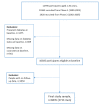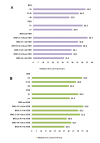Effect of family history of diabetes and obesity status on lifetime risk of type 2 diabetes in the Iranian population
- PMID: 35939397
- PMCID: PMC9359461
- DOI: 10.7189/jogh.12.04068
Effect of family history of diabetes and obesity status on lifetime risk of type 2 diabetes in the Iranian population
Abstract
Background: Data are scarce for the lifetime risk of diabetes in the Middle East and North Africa region countries. We estimated the lifetime risk of type 2 diabetes among Iranian adults at age 20 and 40 years, and their variation by family history of diabetes and body mass index (BMI).
Methods: The data from 8435 diabetes-free participants from the Tehran Lipid and Glucose study were used in this analysis. We estimated the lifetime risk of diabetes stratified by sex, and quantified the impact of family history of diabetes and BMI status on the lifetime risks, singly and jointly.
Results: At age 20 years, the overall lifetime risk of diabetes was 57.8% (95% CI = 54.0%-61.8%) for men and 61.3% (57.2%-65.4%) for women. Having both family history of diabetes and increased level of BMI, alone, increased the lifetime risk of diabetes in both sexes. Moreover, the simultaneous presence of family history of diabetes and overweigh/obesity increased the lifetime risk of diabetes in both sexes. So that, at age 20 years the lifetime risk in obese men with positive family history of diabetes was about 54% higher, compared to normal weight men without family history of diabetes; the corresponding value for women was 42%. Also, normal weight men without family history of diabetes lived 24 years longer free of diabetes, compared with obese men with family history of diabetes. In women, the corresponding value was 20 years.
Conclusion: Our study shows the alarming lifetime risk of diabetes across the strata of BMI, which emphasizes the need for more effective interventions to reduce incidence, particularly, among individuals with positive family history of diabetes.
Copyright © 2022 by the Journal of Global Health. All rights reserved.
Conflict of interest statement
Disclosure interest: The authors completed the ICMJE Disclosure of Interest Form (available upon request from the corresponding author) and disclose no relevant interests.
Figures





Similar articles
-
Prevalence and determinants of diabetes and prediabetes in southwestern Iran: the Khuzestan comprehensive health study (KCHS).BMC Endocr Disord. 2021 Jun 29;21(1):135. doi: 10.1186/s12902-021-00790-x. BMC Endocr Disord. 2021. PMID: 34187451 Free PMC article.
-
Lifetime risk of cardiovascular disease stratified by traditional risk factors: Findings from the cohort of Tehran lipid and glucose study.Hellenic J Cardiol. 2023 Sep-Oct;73:36-46. doi: 10.1016/j.hjc.2023.03.003. Epub 2023 Mar 11. Hellenic J Cardiol. 2023. PMID: 36914096
-
Lifetime risk of diabetes in metropolitan cities in India.Diabetologia. 2021 Mar;64(3):521-529. doi: 10.1007/s00125-020-05330-1. Epub 2020 Nov 23. Diabetologia. 2021. PMID: 33225415 Free PMC article.
-
Diabetes prediction, lipid accumulation product, and adiposity measures; 6-year follow-up: Tehran lipid and glucose study.Lipids Health Dis. 2010 May 10;9:45. doi: 10.1186/1476-511X-9-45. Lipids Health Dis. 2010. PMID: 20459710 Free PMC article.
-
Prevalence of obesity, central obesity and the associated factors in urban population aged 20-70 years, in the north of Iran: a population-based study and regression approach.Obes Rev. 2007 Jan;8(1):3-10. doi: 10.1111/j.1467-789X.2006.00235.x. Obes Rev. 2007. PMID: 17212790 Review.
Cited by
-
Factors affecting Hemoglobin A1c in the longitudinal study of the Iranian population using mixed quantile regression.Sci Rep. 2023 Jun 12;13(1):9565. doi: 10.1038/s41598-023-36481-x. Sci Rep. 2023. PMID: 37308493 Free PMC article.
-
Cardiovascular Risk Factors in Socioeconomically Disadvantaged Populations in a Suburb of the Largest City in Western Romania.Biomedicines. 2024 Sep 2;12(9):1989. doi: 10.3390/biomedicines12091989. Biomedicines. 2024. PMID: 39335503 Free PMC article.
-
Relative importance of triglyceride glucose index combined with body mass index in predicting recovery from prediabetic state to normal fasting glucose: a cohort analysis based on a Chinese physical examination population.Lipids Health Dis. 2024 Mar 8;23(1):71. doi: 10.1186/s12944-024-02060-w. Lipids Health Dis. 2024. PMID: 38459527 Free PMC article.
-
Clinical features of early-onset type 2 diabetes and its association with triglyceride glucose-body mass index: a cross-sectional study.Front Endocrinol (Lausanne). 2024 Mar 11;15:1356942. doi: 10.3389/fendo.2024.1356942. eCollection 2024. Front Endocrinol (Lausanne). 2024. PMID: 38529395 Free PMC article.
-
Association Between ABCG1/TCF7L2 and Type 2 Diabetes Mellitus: An Intervention Trial Based on a Case-Control Study.J Diabetes Res. 2025 Feb 26;2025:9356676. doi: 10.1155/jdr/9356676. eCollection 2025. J Diabetes Res. 2025. PMID: 40225014 Free PMC article.
References
-
- Saeedi P, Petersohn I, Salpea P, Malanda B, Karuranga S, Unwin N, et al. Global and regional diabetes prevalence estimates for 2019 and projections for 2030 and 2045: Results from the International Diabetes Federation Diabetes Atlas, 9th edition. Diabetes Res Clin Pract. 2019;157:107843. - PubMed
-
- Esteghamati A, Larijani B, Aghajani MH, Ghaemi F, Kermanchi J, Shahrami A, et al. Diabetes in Iran: prospective analysis from first nationwide diabetes report of National Program for Prevention and Control of Diabetes (NPPCD-2016). Sci Rep. 2017;7:13461. 10.1038/s41598-017-13379-z - DOI - PMC - PubMed
MeSH terms
LinkOut - more resources
Full Text Sources
Medical
